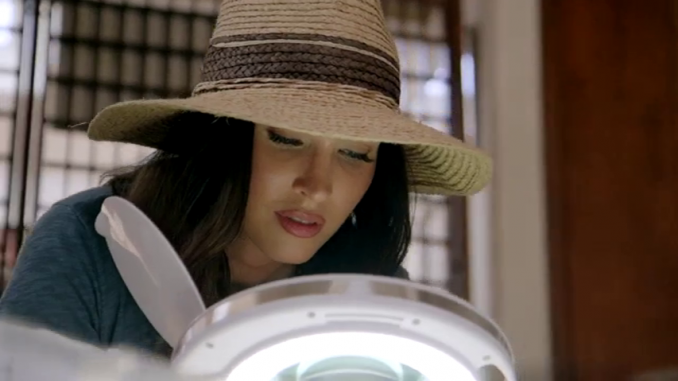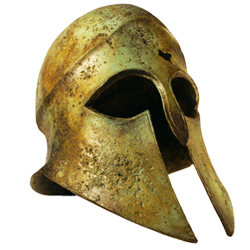
In this review of the fourth and, hopefully, the last episode of Legends of the Lost with Megan Fox, the fact that Megan Fox wore this ridiculously large hat was maybe the most interesting thing about the show.
And it wasn’t even a crazy idea since it probably provided some good shelter from the sun!
By and large, this episode was dry. It was boring. Very little was presented that wasn’t already well established, understood, or otherwise known to those who even casually study Aegean archaeology and the Bronze Age in the Mediterranean region. So I’m not really going to go point-by-point or expert-by-expert as I did with the other shows.
I concede that if you aren’t well-read on the topic, what Fox presented can serve as a tiny appetizer to a much larger meal that the study of Bronze Age Aegean history and archaeology would entail.
She did, however, make a couple statements that were just nonsense. The first being in the earliest three minutes where she said something to the effect of, “they found the walls of Jericho and that was a real location and there was a real wall that fell.” This was part of her defense of using Homer’s Iliad as a source of factual information in the same way the Bible is a source of factual information.

What Fox doesn’t say, and probably doesn’t know, is that the walls of Jericho as told in Biblical mythology aren’t exactly the same as those of reality. In the Book of Joshua, the anonymous author of this work talks of a time around 1,400 BCE and of massive walls around the city of Jericho that were finally brought down by marching the Ark of the Covenant around it for seven days while blowing trumpets.
The reality was that the walls dated to about 8,000 BCE (about 6,000 years before the noisy Joshua) and were under 2 meters high on average. In fact, because there was a 8 meter wide ditch (almost 3 meters deep) that surrounded the wall, some think the wall may have been a flood control method. Or it may have been defensive. Either way, the Neolithic wall was more distant in time to Joshua than Joshua is to us! Other features within the Tell es-Sultan might be closer and there were walls built by the Hyksos people occupying the site and were of much larger size but unstable. They collapsed around 1,573 BCE during an earthquake, over 150 years before Joshua’s campaign against the Canaanites.
Joshua’s campaign was originally written down around 722 BCE about events that supposedly occurred around 1,400 BCE.

Ironically, the Jericho story told in Joshua was probably exactly like the story Homer was telling of Troy in the Iliad. But for reasons different than those Fox thinks. Homer probably wrote the Iliad down around the 8th or 7th century BCE. But it speaks of a time at around 400 or so years prior, which was right before the Greek Dark Ages. This was what is commonly called the Bronze Age Collapse, a period in which historical knowledge goes dark. There just isn’t much left of societies to write it all down or otherwise record it.
During this period, an entire system of writing for the Greek language, known as Linear B, just stopped being used. The archaeological record shows widespread famine, drought, and depopulation throughout the Eastern Mediterranean from Greece in the Aegean to Gaza in the Levant. And it was the fall of the Mycenaean civilization. The reasons have been suggested to be climate change, environmental catastrophe, the introduction of iron weapons and invasions by the Sea Peoples, and so on. But no single explanation stands out when the archaeological record is looked at in various localities.

This is important because so very little was recorded. The Trojan War was said to have occurred prior to this societal collapse and Homer is said to have written it down following the period of collapse. So how did he know? Scholars like Milman Perry suggest that Homer didn’t originally write either the Iliad or the Odyssey. Rather, he wrote down a story that was already being told and passed along from oral tradition. In order to maintain its fidelity, the orally transmitted story used linguistic tools like “stock epithets” and “reiteration” to maintain a structural frame work.
In short, a story that existed 400 years as an oral tradition will probably have some embellishments and changes within if only to suit the changes in audience over time.
Legends of the Lost with Megan Fox – An Overview
I predicted that she would largely stick to generally accepted science for most of the topics that were announced back in November, switching to the crackpot theories and fringe archaeologists at an increasing rate as the shows went on. The Travel Channel switched up the order of the shows, but I think she stuck to this prediction fairly well.
In interviews during the last couple of years, Fox poo-poo’d what she calls the “mainstream” in archaeology and academia in general, but she leaned on it heavily for her series. Expert and knowledgeable academics like Dan Carlson, Si Cleggett, and Catrine Jarman talked with authority and it was clear that they were not only experts in their fields, but enthusiastic and knowledgeable as well.
Where she interviewed hacks like Graham Hancock, Jose Riverwind, and Jim Vieira about things like Nephilim and giants, something was clearly missing. These folks lacked the same professional authority and clarity that comes with having a serious focus on the topic of archaeology.
Finally, I close with saying that I don’t think there was any net gain or loss with this show being aired on the Travel Channel. If there were viewers who had no opinions or knowledge on the topics she presented were to be found, they’re probably no smarter or dumber than they were when they started. The nonsense about giants, magic, lost civilizations with high technology, ley lines, etc. probably cancelled out any real understanding they gained about Vikings, Stonehenge, Troy, or the peopling of the Americas.
Leave a Reply
You must be logged in to post a comment.